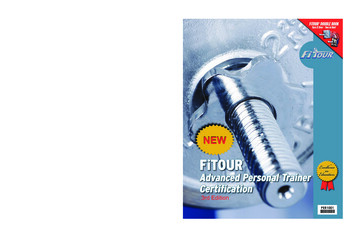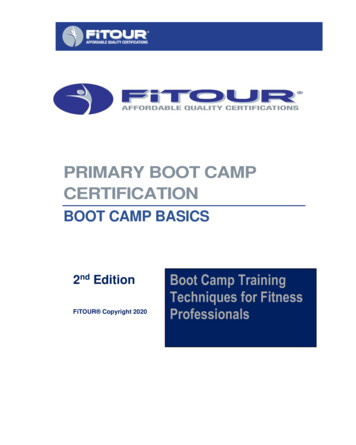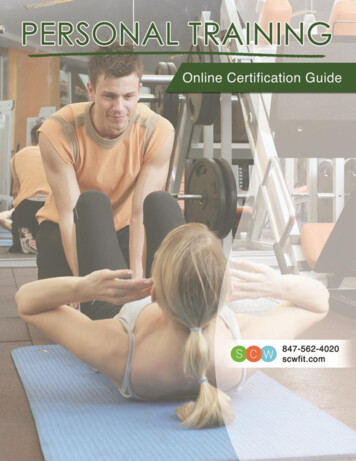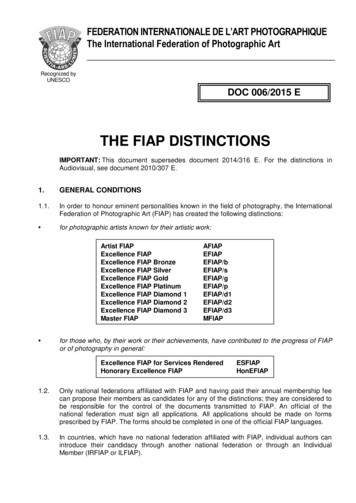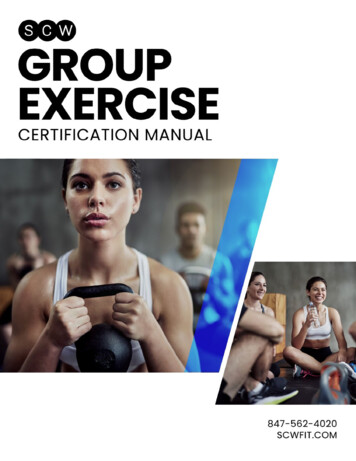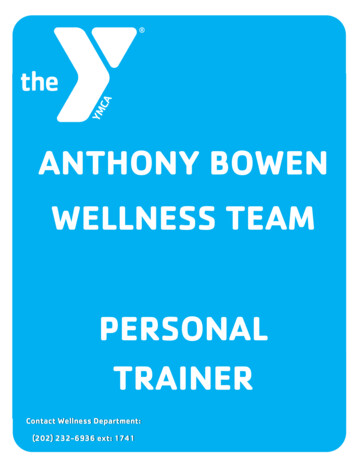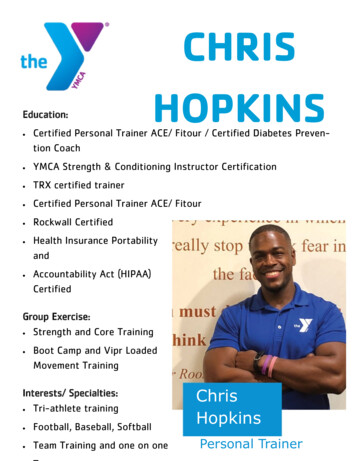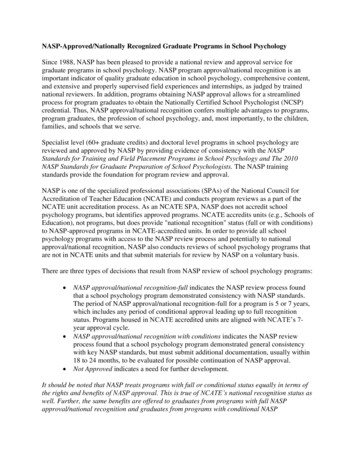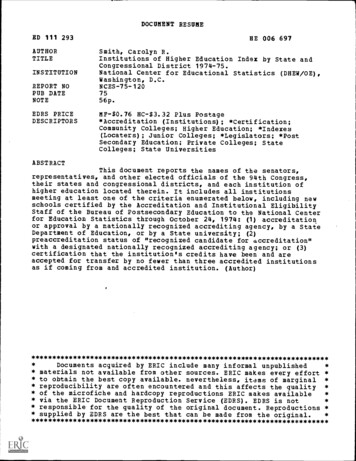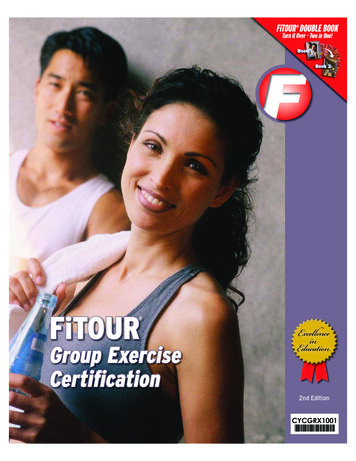
Transcription
KFLI ;FL9C 9FFB Klie k Fm\i Knf e Fe\ 9ffb (9ffb ) KFLI iflg o\iZ j\ :\ik ÔZXk feExcellenceinEducation)e[ [ k fe
Welcome to FiTOUR Providing Fitness Professionals with Affordable Quality Education for Over 25 Years.FiTOUR EXAMDirections, Information & Rules*You are about to begin studying for the FiTOUR Primary Group ExerciseCertification or AFAA CEC Course.This manual will cover the material for bothexaminations.*Certification & CEC Course Exam Access:We encourage registrants to study thematerial, complete the chapter review worksheets, and prepare to take the examination within 90 days ofregistration. You have one full year from date of purchase to access the Certification Exam andthe CEC Course Exam.*Certification & CEC Course Materials Online The online study manual and theonline video are located in your account with FiTOUR in your Study Center. The video follows along withthe manual.*Certification & CEC Course Timed Exam When you have completed the studymaterials and are prepared to take the online exam, log into your Fitour account, click on “Exam Center”and choose the correct exam. This is a timed 3 hour exam that you must complete within the timed 3 hours.You cannot start and stop the exam. Link to the FiTOUR Online Exam UserGuide: ification CertificateOnce you take and pass the certification exam, you can print thecertificate of certification yourself or have FiTOUR mail you a certificate by logging into your account withFitour , click on Certifications and choose certificate option.*CEC CertificateOnce you take and pass the cec course exam, you can print the CEC Certificateyourself by logging into your account with Fitour , click on CEC Course Credits and print.
*Certification Exam FailedIf you do not pass the exam with a 75% or higher you canpurchase a Retest for 25.00 at www.fitour.com/retest*CEC Course Exam FailedIf you do not pass the exam with a 75% or higher you canpurchase a Retest for 25.00 at https://www.fitour.com/retest/cec*Certification RenewalFiTOUR Certifications must be renewed every two years. You willpurchase a 25 online FiTOUR Cec course to renew. Renewal information is availableat http://fitour.com/renewal*Submitting CEC CertificateFiTOUR CEC Certificate with course number; per providerregulations; certificate must be submitted by customer to AFAA within the appropriate time set by AFAAapplicable for AFAA certification renewals.*FiTOUR certifications are nationally recognized and are accredited by the American Council onFitness Education, http://qualityfitnesseducation.com
Table Of ContentsObjectives of Group Exercise Instructor.1Definition of Group Exercise/Instructor.1Responsibilities of a Group Exercise Instructor.1Leadership Qualities.1The Business of Instructing Group Exercise .2Fitness Theory.3Definition of Physical Fitness, Health, and Wellness .35 Components of Fitness and Guidelines .5F.I.T.T. Principle Applied .7Training Concepts and Terms .8Basic Anatomy .10Basic Physiology .12Basic Kinesiology and Biomechanics.15Exercise Safety and Injury Prevention .18Safety Guidelines .18R.I.C.E.M.18Risk Factors .21Special Populations.22Basic Nutrition and Weight Management .26How to Instruct Group Exercise.30Class Format/Guidelines .30Music .33Building Choreography.34Monitoring Intensity .38Choosing Equipment .39Motivating the Class .40Exercise Adherence .42Teaching Specific Classes .43Hi/Lo Aerobics . 43Step .44Cardio Kickboxing .46Funk/Hip-Hop/Street Dance .48Circuit Training .49Interval Training.52Sports Conditioning .54Group Resistance Training.57Core Conditioning.59Water Exercise .62Teaching Flexibility.65Appendices.68References .75Copyright 2005/Updated 2007 by FiTOUR
Objectives of Group Exercise InstructorDefinition of Group Exercise Formally known as aerobic dance exercise, exercise in a group setting has evolved and expandedover the years to encompass several modalities of exercise including step, hi/lo, kickboxing, cycling, aqua, funk, muscle conditioning, etc. Now called Group Exercise, or its more recognized andmodernized name Group X, this social interaction workout between instructor and students hasdeveloped into a billion dollar business for clubs, fitness equipment companies, fitness apparelcompanies, electronic and technology companies, and for the instructor himself/herself.Group Exercise Defined: An exercise format that incorporates several different modalities of exercise that is taught in a group setting by one or more professionally trained instructors.Group Exercise Instructor Defined: An individual who is professionally trained and certified by anationally recognized organization to teach individuals in a group setting safe and effective exercises.Responsibilities of Group X Instructor Cue Proper Body AlignmentProvide Intensity OptionsSee every individual in classMonitor heart rate and/or perceived exertion periodically throughout the workout.Provide feedback concerning participant performance.Adjust his/her workout to help correct form or answer questions during a class.Encourage participants to select the appropriate movement depending on their fitness level.Provide a few minutes before and after class to answer questions and help participants with technique.Educate participants about who they are and how they can choose positive lifestyle behaviors, andhow to care for their bodies.Use transitions that are smoothComplete First Aid and CPR certificationsObtain Liability InsuranceArrive early to classStay current in the fitness industry by reading and maintaining certificationUse Waivers and Informed Consent Forms (facility may already do this)-See Appendix AObtain Medical Releases from Physician (facility may already do this)-See Appendix CConduct Health Screening: Health History Form and PAR-Q Form (facility may already do this)See Appendix BConduct Fitness Assessments (facility may already do this)Complete Accident Reports when an incident occursWhen substitute teaching (i.e., subbing), show up on time, follow the normal guidelines of the class,and demonstrate humor and enthusiasm. Sometimes when there is not a regular teaching positionavailable, subbing is the best way to get your foot in the door to pick up regular classes.Leadership Qualities Be a good role model inside and outside of the gym setting.Demonstrate good form throughout class.Be a good motivator.Acquire Proficient Communication Skills/Be a good communicator.Assume the role of teacher, guide, and coach.Project a Professional and Positive Image.Recognize weaknesses but capitalize on strengths.1Copyright 2005/Updated 2007 by FiTOUR
The Business of Instructing Group X Liability Instructors should complete and maintain training and certification programs that includeboth theoretical and practical skills. Obtain Waivers Medical Clearance: Before teaching a group exercise class, an instructor should ensurethat participants complete medical releases if applicable. Liability Insurance: Instructors should carry personal liability insurance policies for protection against any law suits. Instructors should teach a proper warm-up and teach exercises within safety parameters. Employee vs. Independent Contractor Instructor Employee (IE) answers to the club management. The IE is directly monitored byhis/her superior and responds to that superior. The club collects membership fees andschedules the instructor on a regular basis to teach specific classes. The club takes taxesout of the instructor’s paycheck. The club is liable for injuries that may occur during agroup exercise class. The Independent Contractor Instructor (ICI) is a fitness professional who acts independently from his/her employer. The ICI usually has a contract with a club to teach variousclasses for a specific fee. The ICI is responsible for carrying his/her own liability insurance.The ICI is also responsible for reporting his/her income and paying taxes to the government. Marketing Yourself and Your Fitness Classes: Revenue is the bottom line for clubs, and Group Xnumbers mean revenue. In order for instructors to keep classes, the instructors need to increasetheir participation numbers otherwise there is a risk that the class will be cancelled and or replacedby a new class and sometimes even a new instructor. Word of mouth is the best marketing andpromotion an instructor will receive to grow participation numbers. Here are a few suggestions toimprove the attendance of your group exercise classes. Write press releases to promote your classes in local magazines and newspapers. Attend health fairs at local schools, universities, and hospitals. Create a repertoire with school teachers and invite them to attend classes. Provide fitness topics/tips for local radio and T.V. spots. Book yourself to speak at functions promoting health and fitness. Job Opportunities Gyms, Health Spas, Private Studios, and Country Clubs Community Centers YMCAs International Resorts Gated Community Health Clubs Professional Team Instructor Cruises Governmental Organization Instructor (ex. Fire Department, Police Department, etc.)2Copyright 2005/Updated 2007 by FiTOUR
Fitness TheoryPhysical FitnessDefined: An improved physiological state that leads to improved health and longevity. A set of attributes that people have or can achieve relating to their ability to perform physical activities. Physical Fitness can be divided into 4 categories, Physiological-Related, Health-Related, Skill-Related, and SportsRelated. Physiological-Related: Includes non-performance components of physical fitness that relate to biological systems that are influenced by one's level of habitual physical activity. Metabolic Fitness: The state of metabolic systems and variables predictive of the risk fordiabetes and cardiovascular disease (blood sugars, blood lipids, etc.) which can be favorably altered by increased physical activity or regular endurance exercise. Morphological Fitness: A non-performance component of fitness related to body composition factors such as body circumferences, body fat content, and regional body fat distribution. Bone Integrity: A non-performance component of fitness related to bone mineral density. Health-Related: Consists of those components of physical fitness that have a relationship withgood health. Cardiorespiratory Fitness Muscular Endurance Muscular Strength Flexibility Body Composition Skill-Related: Consists of those components of physical fitness that have a relationship with enhanced performance in sports and motor skills. Agility Balance Coordination Power Speed Reaction Time Sports-Related: Once an individual has developed the necessary physical fitness attributes, he/shecan apply specific skills to sports. Skills are developed over time through patience, practice, andprecision. Team Individual LifeHealthDefined: A state of being associated with freedom from disease and illness that also includes a positivecomponent (wellness) that is associated with a quality of life and positive well-being.WellnessWellness is a state of being describing a state of positive health in the individual and comprising biological and psychological well-being as exemplified by quality of life and a sense of well-being.3Copyright 2005/Updated 2007 by FiTOUR
Benefits of Physical Activity Reduces Risk of Dying PrematurelyReduces the Risk for Cardiovascular DiseaseDecreases Resting Heart RateImproves Core StrengthIncreases Resting Metabolic RateImproves Back StrengthPromotes Joint StabilityStrengthens BonesIncreases Muscle Mass and Decreases Body FatLowers the Risk for Contracting DiabetesLDL Cholesterol Decreases, HDL Cholesterol Increases, and Total Cholesterol DecreasesImproves Balance, Coordination, and AgilityReduces DepressionAssists in Stress ManagementSelf Esteem IncreasesBody Image ImprovesBeing Healthy vs. Being Fit There is a difference between being healthy and being fit. The outcome will depend on how onemoves his/her body.One is physically active in order to be healthy. One accumulates 30 minutes of daily activity to achieve health.One exercises in order to be fit. One exercises 3-5 days a week at an intensity level of 60-90% of Maximum Heart Rate for20-60 minutes per session to achieve fitness.4Copyright 2005/Updated 2007 by FiTOUR
Five Components of Fitness and GuidelinesCardiorespiratory Fitness (CRF)- A measure of the heart’s ability to pump oxygen-rich blood to theworking muscles Cardio– Heart Respiratory– Lungs and Ventilation Vascular– Blood Vessels Aerobic– Working with Oxygen Anaerobic– Working without Oxygen Measurement of Cardiorespiratory Fitness 3-minute step test 1.5 Mile Walk/Run Cardio Training Guidelines 3-5 days/week 20-60 minutes per session 60-90% of MHRMuscular Endurance– The ability of a muscle to perform repetitive contractions over a period of time orthe ability to sustain an amount of weight over a period of time. Abdominal Curl-up Test Push Up TestMuscular Strength– The ability of a muscle to generate the maximum amount of force in a single effort. Measurement 1 Repetition Maximum (1RM) Test (Bench Press/Leg Press) Vertical Jump Test Dynamometer Test (Grip Test) Resistance Training Guidelines Minimum 2 days/week 8-10 major muscles 8-12 reps/1-2 sets5Copyright 2005/Updated 2007 by FiTOUR
Flexibility– The ability to move a joint through a full range of motion without discomfort or pain. Measurement Sit and Reach Test Shoulder Reach Flexibility Test Stretching Guidelines At least 3 days/week Stretch all major muscles to a feeling of mild discomfort Hold each stretch 15-30 seconds Repeat each stretch 3-5 timesBody Composition– Relative percentages of various components of the body, usually divided into fatmass (%of body fat) and fat free or lean mass (%fat free mass). Fat Mass– Subcutaneous Adipose Tissue Lean Mass– Muscles, bones, blood, organs, skin, hair, teeth, etc. Measurement Hydrostatic Underwater Weighing– Gold Standard Skinfold Calipers Infrared Bioelectrical Impedance Body Fat Standards for Active Individuals Men– 5-15% Women– 15-25%6Copyright 2005/Updated 2007 by FiTOUR
FITT Principle: The 3 principles involved in all progressive exercise programs.Frequency: How often one exercises during the week or the number of sessions one exercises duringthe week.Intensity: How hard one works during an exercise session.Time (Duration): The length of the exercise session.Type: The modality of exercise being executed.FITT Principle Applied to Cardio/Muscular Endurance & Strength/Flexibility Cardiovascular (Aerobic) Training Frequency: 3-5 Days a Week Intensity Guidelines for Monitoring Intensity (See also page 41) 60%-90% of MHR (Age Predicted Maximum Heart Rate) 50%-85% of VO2max or HRR (Heart Rate Reserve) Time 20-60 minutes of continuous vigorous activity When just beginning, do as much as you can 1996 Surgeon General’s Report– Accumulate 30 minutes of vigorous activity throughoutthe day for health purposes. Resistance Training Frequency: Minimum 2 days/week Intensity: 8-10 Major Muscles Time: 8-12 Reps/1-2 SetsFor continued muscular development increase to 3 sets and heavier load Flexibility Frequency: At least 3 days/week or after every workout Intensity: Stretch all major muscles to the point of mild discomfort Time: Hold each stretch 15-30 seconds/Repeat each stretch 3-5 sets7Copyright 2005/Updated 2007 by FiTOUR
Below are a series of questions designed to help you remember the course material efficiently.Before proceeding to the next page of the course content, please answer the following reviewquestions.Section # 1 Review Questions1. What is the definition of Group Exercise?2. List the responsibility of the Group Exercise Instructor:3. Explain the business of the instructor for Group Exercise:4. List the Benefits of Physical Activity:5. Name the Five Components of Fitness:A.B.C.D.E.
Training Concepts and Terms Acclimatization: A physiological adaptation to a new environment (higher altitude, temperature, orhumidity). It may take 7 to 12 days to acclimate to different environments. Adherence: A state of continuing an exercise program as prescribed. Aerobic Activities: Sub-maximal intense activities that use large muscle groups with energy supplied in the presence of oxygen that can be performed for a long period of time. Agility: Ability to start, stop, and move the body quickly in different directions. Anaerobic Activities: High intensity activities during which energy demands exceed the ability tosupply oxygen and cannot be performed for a long period of time. Balance: The ability to maintain a certain posture or to move without falling; symmetrical. Conditioning: Exercise conducted on a regular basis over a period of time (“training”). Coordination: The ability to perform a task integrating movements of the body. Cross Training: Incorporating different modalities of exercise into one’s overall training regimen toavoid over-training, boredom, and/or plateau. Delayed Onset of Muscle Soreness (DOMS): Muscle soreness that occurs 1-2 days after an exercise training session. Efficiency: The ratio of energy expenditure to work output. How well an individual can perform orexecute an exercise. Fartlek (Speed Play): A form of physical conditioning which alternates fast and slow running overvaried terrain for 3-4 miles. Force: Any push or pull that tends to cause movement Interval Training: A fitness workout that alternates harder and lighter bouts of intensities throughoutthe session. Overload Principle: To place greater than usual demands upon some part of the body. Periodization: A specific period of time (weeks, months, or years) over which the frequency , volume, and intensity of training are systematically varied to avoid over-training and to promote continued progress. Plyometrics: A method of resistance training that emphasizes the stretching of the muscle prior tothe contraction.8Copyright 2005/Updated 2007 by FiTOUR
Power: The ability to exert muscular strength quickly.Expressed as Force X Speed Power Progressive Overload Principle: Introducing overloads in a systematic manner. Rest: One must plan days of rest to yield an improvement in one’s overall performance Active Rest– Days that consist of light, fun activities different from one’s normal workoutprogram Passive Rest– Days that consist of doing no activity. Reversibility: A marked decrease in endurance, muscular strength, and flexibility with the cessationof exercise Muscular Strength– Begins to reduce after 72 hours of cessation Cardiovascular Endurance– Begins to reduce after 2 weeks of cessation Specificity Concept: The idea that one should train in a specific manner to achieve a specific outcome. Speed: The ability to move the whole body quickly. Training Effect: Overall positive improvements in the performance of the heart, lungs, and musclesdue to conditioning. Training Variation: Systematically manipulating training variables to create an overload therebydemanding the body to adapt and improve.9Copyright 2005/Updated 2007 by FiTOUR
Below are a series of questions designed to help you remember the course material efficiently.Before proceeding to the next page of the course content, please answer the following reviewquestions.Section # 2 Review QuestionsFill in the blank1. is the ability to start and stop and move the body in differentdirections.2. is the ability to perform a task integrating movements of thebody.3. is to place greater than usual demands upon part of thebody.4. is any push or pull that tends to cause movements.5. is a state of continuing an exercise program asprescribed.6. is the ability to maintain a certain posture.7. is a method of resistance training that emphasizes thestretching of the muscle prior to the contraction.8. is exercise conducted on a regular basis over a period oftraining.9. is the ability to exert muscular strength quickly.10. is the ability to move the whole body quickly.
Basic AnatomyAnatomy Definition—The structure of the human body. Muscle Striated or Skeletal Muscle: The anatomical structure that provides the force necessaryto move the body. Myology: The study of musclesMuscular Anatomical Figure10Copyright 2005/Updated 2007 by FiTOUR
Bone: The anatomical structure that provides support, movement, and protection for the body.Osteology: The study of bonesSkeletal Anatomical rtebraeUlnaOs coxaeCoccyxSacrumRadiusFemurMetacarpal BonesPhalangesPatellaFibulaTibiaTarsalsMetatarsal BonesPhalanges11Copyright 2005/Updated 2007 by FiTOUR
Basic PhysiologyDefinition—Physiology is the study of human body function.Muscles 3 Types Smooth (Involuntary) Cardiac (Involuntary) Skeletal/Striated (Voluntary): About 400 Structure Muscle(Fasciculus– A bundle of muscle fibers surrounded byperimyseum) Muscle Fiber Myofibril Sarcomere: Fundamental Unit of Contraction Actin—Thin Filament Myosin—Thick Filament Motor Unit: The functional unit of muscular contraction that includes a motor nerve and the muscle fiber that its branches innervate. Muscle Contraction: Muscles apply force by contracting and pulling on bones. All or None Law: Given a threshold or supra threshold stimuli, a muscle fiber willcontract all the way or not at all. Sliding Filament Theory: The actin slides over the myosin pulling the ends of thesarcomere together creating a contraction and shortening the muscle. Isotonic Contraction: A muscle contraction in which the force of the muscle isgreater than the resistance, resulting in joint movement with shortening of the muscle. Concentric Phase: A shortening of the muscle as a result of its contraction; Eccentric Phase: A lengthening of the muscle during its contraction; resists movement caused by another force Isometric Contraction: A muscle contraction in which the muscle length is unchanged. Isokinetic Contraction: A muscle contraction with controlled speed, allowing maximal force to be applied throughout the range of motion. Muscle Mass Changes from Resistance Training Hyperplasia Theory: An increase in muscle size due to muscle fibers splitting andforming separate fibers. Hypertrophy: An increase in muscle size due to the cross-sectional area of themuscle increasing in size.12Copyright 2005/Updated 2007 by FiTOUR
Muscle Fiber Types Type I Slow-Oxidative (SO) Also known as Slow-Twitch Fiber Speed of Contraction: Slow Force: Low Resistance to Fatigue: High Type IIa Fast Oxidative Glycolytic (FOG) Also known as Intermediate Fiber Speed of Contraction: Fast Force: High Resistance to Fatigue: High These muscle fibers can be trained to act as either Type I or Type IIb Type IIb Fast Glycolytic (FG) Also known as Fast-Twitch Fiber Speed of Contraction: Fast Force: High Resistance to Fatigue: Low13Copyright 2005/Updated 2007 by FiTOUR
Terms in Metabolic, Cardiovascular, and Respiratory Responses toExercise Energy : Energy comes from Carbohydrates, Fats, and Proteins. Energy must be converted toAdenosine Triphosphate (ATP) be used by nerves, muscles, and other cells. Oxygen Uptake: The rate at which oxygen is utilized during a specific level of an activity. Oxygen Deficit: The difference between the theoretical oxygen requirement of a physical activityand the measured oxygen uptake. Steady State: The point during exercise at which oxygen uptake is unchanging or changes verylittle. Oxygen Debt or Excess Postexercise Oxygen Consumption (EPOC): The amount of oxygen usedduring recovery from work that exceeds the amount needed for rest. VO2max: The greatest rate of oxygen utilization attainable during heavy work. Expressed in L-minor ml-kg-1-min-11 Heart Rate: The number of beats of the heart per minute . Stroke Volume: The amount of blood pumped in one beat of the heart . Cardiac Output: The amount of blood circulated by the heart in one minute.Formula Expressed as Heart Rate X Stroke Volume Cardiac Output Blood Pressure: The pressure exerted by the blood on the vessel walls, measured in milliliters ofmercury by the sphygmomanometer. Pulmonary Ventilation: The process of oxygenating the blood through the lungs. Lactate Threshold (Ventilation Threshold): The point during a graded exercise test at which theblood lactate concentration suddenly increases; a good indicator of the highest sustainable workrate. Effects of Endurance Training Increase in # of Mitochondria (The Powerhouse of Cells) Decreased time that it takes to achieve steady state Size of the ventricle of the heart increases, increasing the amount of blood that can bepumped with one beat of the heart. Increased VO2max14Copyright 2005/Updated 2007 by FiTOUR
Basic Kinesiology and Biomechanics Definition—Kinesiology is the scientific study of human movement.Planes of Movement: Flat imaginary surfaces that divide the body into halves in order to correspond with movement, motion, and actions. Human movement occurs in a plane. Median/Sagittal Plane: A vertical plane that passes through the body anterior to posteriordividing the body into right and left sections. Flexion and extension actions occur within thesagittal plane. Frontal/Coronal Plane: A vertical plane that passes through the body from side to side dividing the body into anterior and posterior sections. Abduction and adduction actions occurwithin the frontal plane. Transverse/Horizontal Plane: A horizontal plane that passes through the body dividing thebody into superior and inferior sections. Rotation and twisting actions occur within thetransverse/horizontal plane. Oblique Plane: A plane that lies tilted between the 3 primary planes associated with kinesiology.*Movement within
FiTOUR CEC Certificate with course number; per provider regulations; certificate must be submitted by customer to AFAA within the appropriate time set by AFAA applicable for AFAA certification renewals. * FiTOUR certifications are nationally recognized and a
